When the Queen Elizabeth 2 visited Martha’s Vineyard thirty years ago this month and promptly ran aground, it was the most famous ocean liner in the world. Strictly speaking, if you recognize “liner” as meaning a ship making “line voyages,” or point-to-point journeys, it was the only significant one left.
The keel of the Queen Elizabeth 2 – better known as the QE2 – was laid on July 5, 1965, at the yard of famous shipbuilder John Brown & Co., Clydebank, Glasgow. The shipbuilder had built many Cunarders, including the Queen Mary and Queen Elizabeth, whose maiden voyages were in 1936 and 1946, respectively. At 963 feet and 65,863 gross registered tons – a measure of interior space, not weight nor displacement – at its time the QE2 was a relative giant.
The “Atlantic Ferry,” as the frequent transatlantic crossings once made by the “ships of state” of most European nations and the U.S. were known, was entering its waning years when the QE2 joined in. Legendary ships included Holland America Line’s S.S. Rotterdam, Italian Line twins Raffaelo and Michelangelo, North German Lloyd’s Bremen, Swedish American Line’s Gripsholm and Kungsholm, and Norwegian America Line’s Sagafjord. Perhaps most notable were French Line’s France of 1962, and United States Lines S.S. United States of 1952. (QE2, by the way, is not named after the current British Monarch, but rather after a previous ship of the same name. Hence the Arabic rather than Roman numeral after QE. Cunard’s current Queen Elizabeth, launched in 2010, eschews the numeral altogether.)
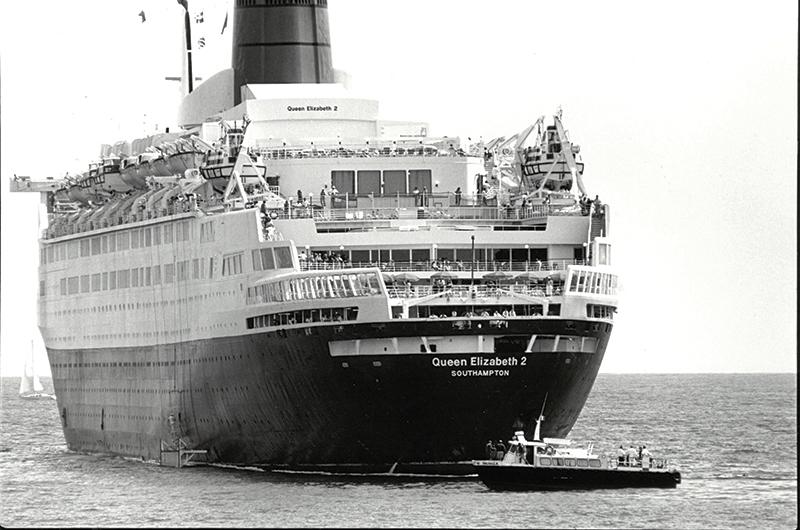
One by one, however, the grand ships were mothballed or cut up for scrap, victims primarily of the rise of air travel. The last liner other than QE2 significantly engaging in transatlantic crossings was the small, slow, modest, old, inexpensive, and altogether wonderful Polish Ocean Lines’ Stefan Batory – truly a “ship of state,” with its outstanding all-Polish crew in an era when all other lines had embraced the economy of “international crewing.” After Stefan Batory made its final voyage in 1988, the QE2 sailed alone, the last of the transatlantic liners. That was the stature of the ship that stubbed its toe off Martha’s Vineyard.
But it wasn’t an Atlantic crossing that brought the ship to the Vineyard in 1992. The QE2 regularly supplemented its dwindling revenue from ocean crossings with short cruises up the New England coast and elsewhere. It first came to the Vineyard in 1985 and had been back most every year since, always anchoring off East Chop so passengers could tender into Oak Bluffs.
On Monday, August 3, 1992, the QE2 left New York City on a five-night cruise to Bar Harbor, Maine; St. John, New Brunswick; Halifax, Nova Scotia; and Martha’s Vineyard. When the ship dropped anchor off East Chop in the early afternoon on Friday, the sky was blue and Nantucket Sound calm, so most passengers took advantage of the chance to tender in to Oak Bluffs and get at least a quick look at what they could see of the Vineyard in half a day before returning to the ship for the scheduled 8 p.m. departure for an overnight run back to New York.
At just after 9 p.m. on August 7, an hour late due to tendering delays, the QE2’s 130,000-horsepower diesel-electric units (installed in 1987 to replace the original steam turbines, which had been somewhat problematic) murmured into action. This delay wouldn’t have posed a problem, since the ship was a speedster, capable in a pinch of thirty-four knots (service speed was twenty-eight-and-a-half knots), slightly better than it could have done with its turbines.
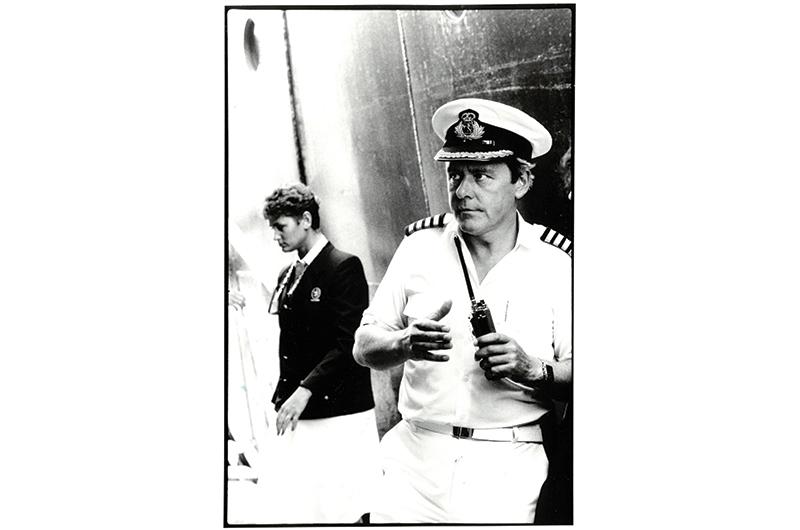
Second-sitting passengers were tucking into their entrées in the Mauretania Restaurant, and those in the elite single-sitting Columbia Restaurant, Princess Grill, and Queen’s Grill were most likely sipping a demitasse or cognac. Passengers were dressed informally by Cunard’s standards, mostly tie and sport jacket for men and cocktail dress or pants suit for women. By long standing ocean-liner tradition, tuxedos and gowns were not expected on the first and last nights out, a matter of convenience, and, in fact, suitcases had already begun to line the corridors to be taken ashore by crew in New York the following morning.
Some who had finished their dinners were enjoying a pleasant, temperate evening on deck as the QE2 steamed up Vineyard Sound, the Elizabeth Islands silhouetted to starboard, the scattered lights of the Vineyard showing to port, the alternating white and red beams of Gay Head Lighthouse pointing the way.
The first Gay Head Light was built in 1799 to warn mariners not so much of the location of the western tip of Martha’s Vineyard but of Devil’s Bridge, a menacing reef of ship-killing rocks that extends northwest from the base of the cliffs. Not all ships succeeded in altering course, including most famously the 275-foot steamer City of Columbus. In January 1884, bound from Boston to Savannah on a moonlit but frigid night, the vessel hit the reef. By the time the tragedy ended, 103 people had died; only twelve passengers and seventeen crew survived.
In 1823, another lighthouse was built directly across Vineyard Sound at the western end of Cuttyhunk. That lighthouse, which is now gone, served a similar purpose. The reef known as Sow and Pigs was noted (though not by that name) as early as 1602 by Bartholomew Gosnold, the first European to explore the Vineyard. Like Devil’s Bridge it has been a graveyard for ships. Most notable, perhaps, was the whaleship Wanderer, which wrecked near the reef in 1924.
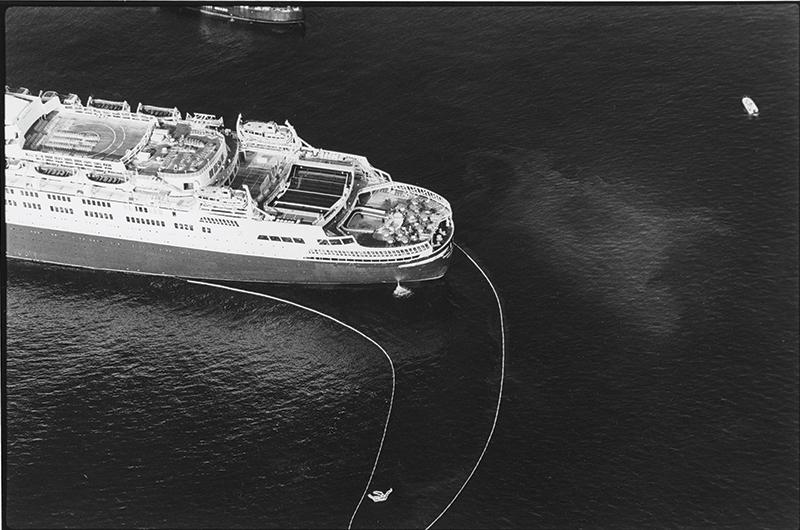
In other words, both reefs have been known to mariners for centuries, as have hundreds of other navigation hazards in the area. The waters between New York and Boston were, in the age of sail, second only to the English Channel in terms of ship traffic. But, as the crew and passengers of the QE2 were soon to discover, not every rock on the bottom made its way onto the charts.
At about 9:48 p.m., with the ship about two-and-a-half-miles south of Cuttyhunk, passengers felt a series of bumps, enough to be alarming to those in the restaurants and lounges or on deck. It was even more alarming to those on the navigation bridge, where the quartermaster at the helm was steering the ordered 250-degree course, and the QE2’s master, Captain Robin Allen Woodall, and John F. Hadley, the pilot, were meant to be collaborating. The fifty-eight-year-old Woodall had been master of the QE2 since 1989 and replacement captain before that.
The first word the passengers received came over the public address system, just minutes after the grounding, that the ship had “struck an unidentified underwater object” and that the vibrations were the shudder of propellers working over a shoal. The passengers were in no danger, the announcement said, and that at least did prove to be true.
The QE2 being the QE2, it was no surprise that celebrities were on the passenger list, including Academy Award–winning film and television actor George Kennedy. In an interview, Wilt Melnick, his personal manager, suggested that the anxiety level among the passengers in the evening after the grounding wasn’t high. “We were trying to think up a drink we could call ‘QE2 on the Rocks,’” he said.
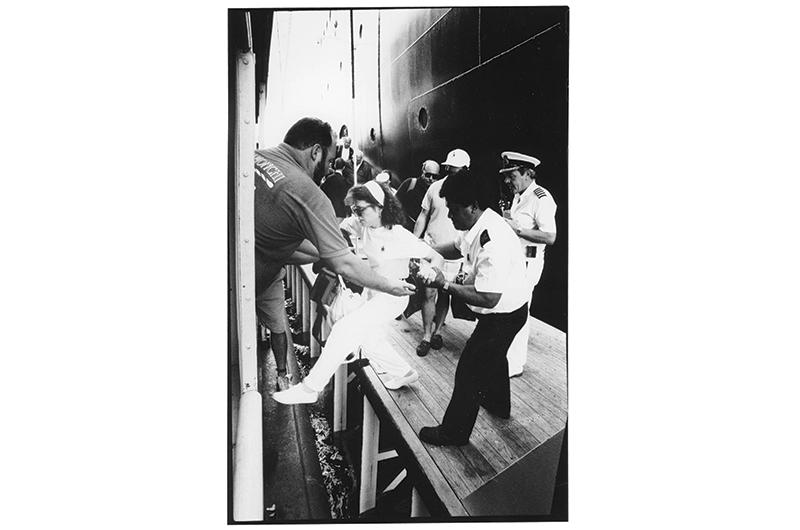
(I have no idea if they came up with one, but I do know that the quip had legs. On a subsequent cruise on a different ship, I saw an off-duty crewman on the pier wearing a T-shirt bearing it. The accompanying image was a little off – an “up” glass for a martini, no ice – but the witty shirt was a reminder of the crew culture always alive below decks.)
On Saturday attention turned to how the grounding could have happened and how to get the passengers to safety. By this time the ship had moved at Coast Guard instruction to a point eight miles southwest of where it had grounded and had anchored, in no danger of sinking. Divers from the Coast Guard buoy tender Bittersweet discovered eight gashes in the ship’s hull, the longest seventy-four feet long and three to six inches wide. Additionally, a ninety-foot National Oceanic and Atmospheric Administration (NOAA) Coast and Geodetic Survey ship was dispatched to search the area of the grounding for what was being called a “mysterious rock or underwater obstacle.”
A source of some amusement for Vineyarders who followed the story in the news was the arrival of the humble New Bedford ferry Schamonchi to evacuate the first-class passengers from the famous ocean liner. Built in Maine in 1978, the Schamonchi was a no-nonsense, bare-bones Vineyard regular and would be until its retirement in 2003. (It was last seen deteriorating on Newtown Creek in the Bushwick section of Brooklyn as a maverick, stationary party boat.)
With master and owner Richard Thompson at the helm, the 150-foot-long ferry came alongside after the diving concluded and embarked the QE2’s 555 first-class passengers (from a total passenger count of 1,824) to transport them to Newport. From there they’d be bussed to Providence, then transferred to an Amtrak train for the final leg back to New York City. QE2 was unique at the time in maintaining even when cruising a remnant of the two-class system that had been the norm in the heyday of the transatlantic liners.
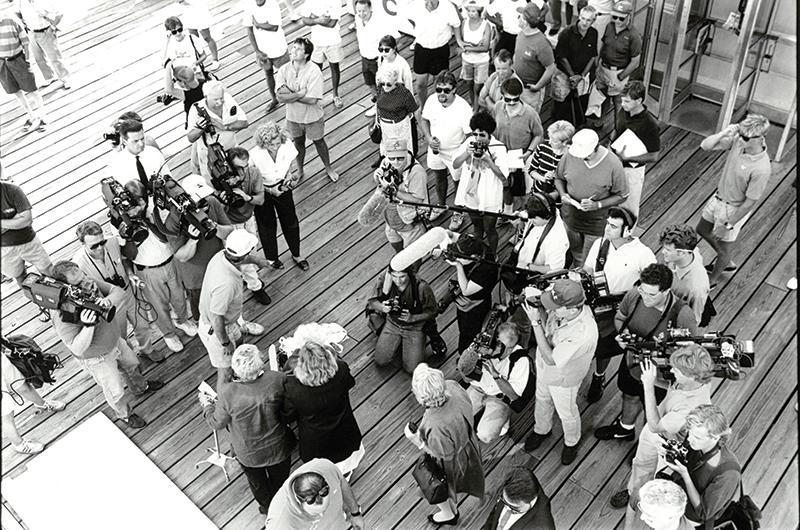
The transatlantic-class passengers may have gotten the better deal, as later Saturday afternoon the Coast Guard gave permission for the QE2 to proceed slowly under its own power to Newport and anchor outside the harbor. From there they were tendered into town, along with most of the roughly 1,000 crew.
On August 10 the wounded QE2 backed into the 1,170-foot dry dock at the General Ship Corporation yard in South Boston, where repairs were substantial, slow, and expensive. Cunard immediately cancelled the liner’s August 8 and 13 transatlantic crossings, and as it turned out the ship did not sail again until October.
Both the Coast Guard and the National Transportation Safety Board (NTSB) studied the grounding in depth and at length – for nearly a year. Their findings, revealed publicly by the Coast Guard on May 27, 1993, were similar. And though they did conclude the rock was uncharted, the crew were not entirely exonerated.
In the words of the NTSB, “the probable cause of the grounding of the QE2 was the failure by the pilot, master, and watch officers to agree on a navigation plan for departing Vineyard Sound and to maintain situational awareness, resulting in the striking of uncharted rocks after an unplanned course change.”
The report also implied that the ship may have been traveling a bit fast under the circumstances, since at certain speeds in shallow water a ship can be drawn down toward the bottom, a phenomenon called “squat.” “Contributing to the accident,” the NTSB report went on to say, “was the lack of information available on the QE2 about how speed and water depth affect the ship’s underkeel clearance...The speed of 25 knots selected by the master and agreed to by the pilot left little margin of error for a vessel of this draft.”
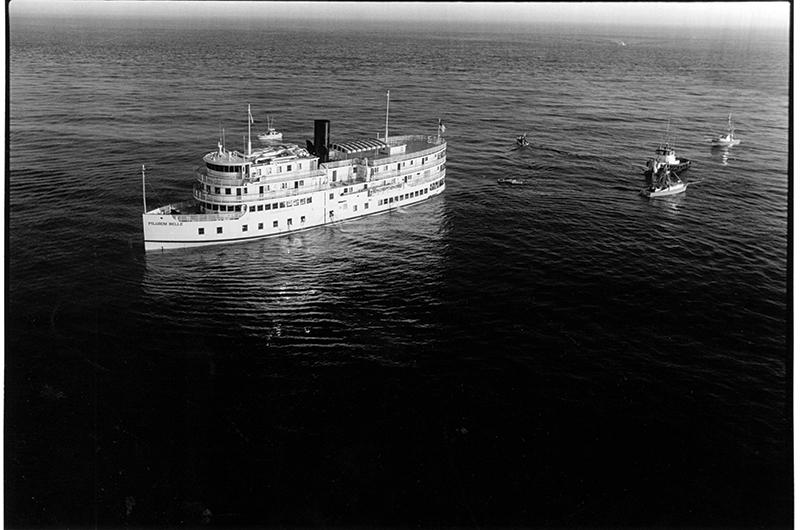
The good ship sailed for another sixteen years. It was scheduled to make two Vineyard calls in 1993, in July and September, but they were rerouted to Bar Harbor and to Newport, and in fact the QE2 never again returned to the Vineyard. Its sailing days over in November 2008, it languished for years in Dubai before its grand opening as the Queen Elizabeth 2 Hotel there in October 2018.
Well, Thanks For Saving My Life, Pilgrim.
The QE2 was not the first cruise ship to be rescued in the area, as only seven years earlier – on Sunday, July 28, 1985 – Coastwise Cruise Line’s pocket cruise ship Pilgrim Belle very nearly sank not far from where the QE2 had its adventure.
Like the QE2, this handsome little vessel, a 192-foot-long convincing replica of a coastwise steamer from the 1920s, was well-known to me and my wife, Laurel. We had boarded one of its first New England cruises, a seven-nighter calling at Nantucket, Martha’s Vineyard, Block Island, Newport, Provincetown, and Plymouth before returning to Hyannis.
Just two cruises later, the ship struck the well-known and notorious Sow and Pigs Reef.
The Pilgrim Belle had left Vineyard Haven as scheduled at 3 p.m., bound for Block Island via Vineyard Sound, with light seas and good visibility. At about 4:30 p.m. the ship inexplicably passed on the wrong side of a buoy marking Sow and Pigs and grounded, tearing a three-by-nine-foot gash in the hull, amidship to port.
Water poured in and Captain Robert Raisch immediately sent out an S.O.S., to which the Coast Guard responded with ships and helicopters. Pleasure and fishing boats came too. Lifeboats were put over and Raisch gave the order to abandon ship. All eighty-five passengers were taken off and sixteen crew. Seven crew members remained on board to man the gasoline-powered pumps that were delivered by the Coast Guard; eventually there were twenty of these, many of them pumping 250 gallons per minute. Coast Guard vessels came from Menemsha, Woods Hole, and Provincetown and helicopters from Otis Air Force Base on Cape Cod.
Passengers were picked up by various vessels, among them the fishing boat Fare Lady, which took forty-six to Woods Hole, and Dorsal Jr., a pleasure boat, which took ten to Cuttyhunk. Six passengers were taken to Falmouth Hospital, examined, and released, and all ended up in hotels in Hyannis before returning home.
Twenty-one-year-old Cathy Foss, a deck hand just promoted from stewardess, had been at the helm when the ship grounded. Foss was under the instruction of the ship’s mate, forty-year veteran Richard Currier, who the Coast Guard said had been given an improper bearing by captain Raisch. Captain Raisch was later terminated and charged with negligence by the Coast Guard.
The Pilgrim Belle was towed to Fairhaven, Massachusetts, and later to Middletown, Rhode Island, for repairs. It was able to resume its regular cruising by the end of that summer, back into Vineyard Sound, but with a different captain.
Today, the ship sails high-end cruises from Seattle to Alaska as The Legacy.





